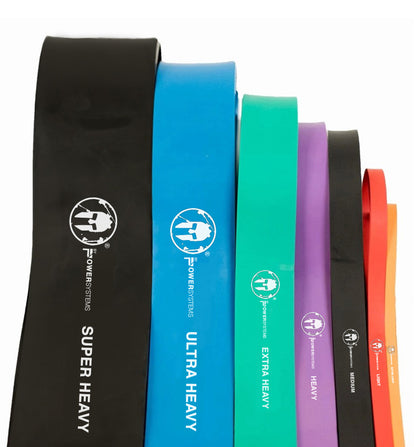How to Do an Insanely Effective At-Home Chest Workout With Bands

Resistance bands have quickly emerged as one of the most effective, versatile fitness equipment in the industry. Personal trainers often use them in place of traditional weights; physical therapists use them to add a variable of resistance to muscle activations while rehabbing injuries; and fitness enthusiasts use them to add either assistance or resistance to their most effective lifts.
Related: Use a Band to Accommodate Resistance Training Exercises For Safer Sets and Greater Gains
Whether you’re attempting at-home workouts with little-to-no equipment, or you’re a frequent traveler with limited access to a traditional gym, resistance bands are the easiest, lightest, and most cost-effective tool to keep with you and ensure consistent training. Resistance bands come in a variety of strengths, providing individuals of all skill and strength levels with a safe alternative to traditional resistance equipment.
What Makes Strength Bands Effective?
Resistance bands can be utilized to mimic exercises for every muscle group. Because of the variable resistance, they will engage the core, recruiting the full kinetic chain with each exercise. This turns a traditional singular muscle group exercise into a total-body exercise. Essentially, your body will not be able to perform any movement with a resistance band unless the core is activated. This type of training helps to eliminate compensations and biomechanical imbalances.
How to Do an At-Home Chest Workout With Bands
This workout involves replacing your dumbbells, cable columns, and other favorite resistance equipment with resistance bands. You'll need to be able to attach the band into a door to effectively complete this workout.
Push-Up Press: 3 sets to failure (modification: can be done on incline/wall)
1. Place your left hand through the band and plant it palm-down on the ground, then loop the band over your back, put your right hand through the band, and plant your right hand palm-down on the ground, shoulder width from the other hand.
2. Assume a prone push-up position, with your elbows fully extended, your navel drawn in, your back neutral, and your feet shoulder width apart.
3. Keeping your elbows tucked in toward your sides (ie. not flaring out laterally), flex your elbows and descend until your chest nearly touches the floor, pause, then push back up. The band adds extra resistance to this common movement.
Chest Press in Bench Bridge: 3 sets of 8-12
1. Loop a resistance band underneath a bench and lay supine with your shoulders resting on the bench, your knees flexed, and your glutes contracted to stabilize your body.
2. Grab the band with both hands and — with your palms up — extend your elbows, pushing up as you would a bench press.
3. Pause at the top of the movement, and slowly return your hands to chest level.
Single-Arm High to Low Fly: 3 sets of 8-12
1. Tie one end of the band to the bottom of a door frame or other sturdy surface (the base of a bed frame, for example). Get down on your knees adjacent to the direction of the band's stretch, and lift the outer knee so only one knee is on the ground.
2. Place your outer hand on your hip, and extend the inner arm (the arm closest to the band's anchor) straight out, gripping the band and holding it taught.
3. Allow the resistance to pull your arm back and down, then apply force to raise your arm (while keeping your elbow extended as much as possible) up and across your chest.
4. Repeat on the opposite side.
Single-Arm Chest Press: 3 sets of 8-12
1. Anchor the end of the band to a door knob or other sturdy, mid-height object. Standing with your feet together and facing away from the door, step forward with one foot (about shoulder width apart) and flex your knee and hip while extending the rear leg's hip and knee so that the front leg is bent and the back leg is straight.
2. Stand with the band on the side of the rear leg, and with the ipsilateral arm, abduct your shoulder, grab the band with a prone grip (palm down) and push forward to extend your elbow fully.
3. Pause at the top of the motion, then return to starting position.
4. Repeat on the opposite side.
Single-Arm Low to High Fly: 3 sets of 8-12
1. Anchor the end of the band to the top of a door frame or another high sturdy object. Get down on your knees adjacent to the direction of the band's stretch, and lift the outer knee so only one knee is on the ground.
2. Similar to the single-arm high to low fly, place your outer hand on your hip, and extend the inner arm (the arm closest to the band's anchor) straight out, gripping the band and holding it taught.
3. Allow the resistance to pull your arm back and up, then apply force to pull your arm (while keeping your elbow extended as much as possible) down and across your chest (horizontal adduction).
4. Repeat on the opposite side.
Wide Push-Up Press: 3 sets to failure (modification: can be done on incline/wall)
1. Very similar to the first exercise, place your left hand through the band and plant it palm-down on the ground. Then, loop the band over your back, put your right hand through the band, and plant your right hand palm-down on the ground, more than shoulder width apart.
2. Assume a prone push-up position, with your elbows fully extended, your navel drawn in, your back neutral, and your feet shoulder width apart.
3. With your hands further than shoulder width apart, flex your elbows and descend until your chest nearly touches the floor, pause, then push back up.













